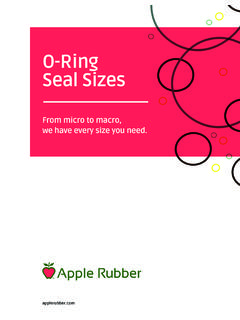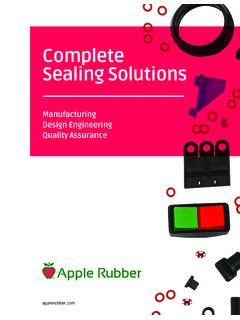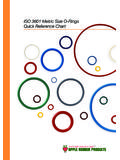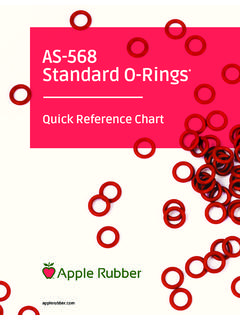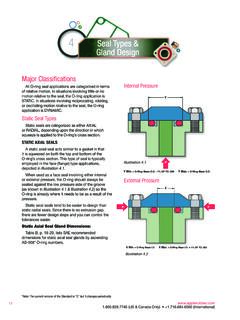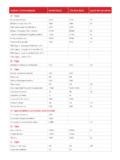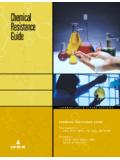Transcription of 6 Material Selection Guide - applerubber.com
1 6 Material Selection Guide Basic Concepts of rubber What is Vulcanization? The long, flexible polymeric chains of rubber , What is rubber ? when heated, react with vulcanizing agents to form rubber refers to elastomeric compounds that three-dimensional structures. These vulcanizing agents consist of various monomer units forming polymers (usually sulfur or peroxide) are necessary to facilitate that are heat cured (vulcanized). Polymers are long chemical crosslinking of polymeric chains. Once molecular chains and are derived from the Greek the rubber has been vulcanized or cured , physical poly (many) and meros (parts). The base monomer properties are enhanced and the compound is more or monomers is used to classify the type of rubber , for resistant to deterioration. example: Nitrile, Silicone or Neoprene. What is Compression Set? What is a rubber Compound? rubber is composed of many different ingredients Elastic recovery is a measure of the elastomer's ability to return to its original shape once a 6.
2 That include the base elastomer, vulcanization agents, compressive force has been removed. Failure of the fillers and plasticizers. For example, the addition of seal to return to its original shape after compression is fillers can reinforce or modify properties, or additional the condition termed compression set and all seals plasticizer can increase elongation and lower durometer. exhibit some degree of compression set. Determination Why Does rubber Act Rubbery ? of the amount of compression set is governed by ASTM designation D395 test procedure. rubber is considered highly viscous liquid or an elastic solid. The polymeric chains in rubber tend to What is the difference between a Thermoset be very long and flexible by nature and can rotate and Thermoplastic? about their axis, which results in an entangled mass of One classification method of polymeric materials contorted chains. is according to physical properties at elevated When a deformation of the rubber occurs, these temperatures.
3 Thermoset polymers become tangled chains uncoil and recoil when the force permanently set in the presence of heat and do is released. Therefore, elastic rebound or rubbery not soften in the presence of subsequent heating. behavior is possible due to contortions of long, flexible Conversely, a thermoplastic Material will soften when polymeric chains, which allow rubber to be so resilient. heated (and eventually liquefy) and harden when cooled. This process is reversible and repeatable, as How is rubber Made? opposed to thermoset polymers where the process is The base polymer is the primary component of irreversible. Also, thermoset polymers possess superior all rubber recipes and is selected in order to obtain mechanical, thermal, and chemical properties as well specific chemical and physical properties in the final as better dimensional stability than thermoplastic product. Processing aids and softeners, such as oils elastomers.
4 This is why thermoset ( rubber ) parts are and plasticizers, modify rubber to aid in mixing or generally preferred for sealing applications. molding operations. Sulfur is one of the most widely This section contains descriptions of the elastomers used vulcanizing agents to promote crosslinking used in seal applications. These elastomers form the which is used in conjunction with accelerators and base of a wide variety of compounds, designated for accelerator activators to reduce cure times and specific applications. Every compound has specific enhance physical properties. Carbon black is one characteristics and many compounds have common of the most common fillers because it reinforces attributes. Therefore, it is important to consider the molecular structure. Antidegradants, such as all aspects of the compound prior to use. Also, as antioxidants and antiozonants, retard the deterioration compound availability is customer driven, lead time of rubber products.
5 Lubricants, colors or any other may vary. miscellaneous ingredients may also be added. 60. (US & Canada Only) + (International). Material Selection Guide Chemical Compatibility Table Chloroprene (Neoprene). Please see the Seal Design Guide Online Trade Name(s): for the full Chemical Compatibility table. Neoprene .. DuPont Performance Elastomers Baypren .. Bayer ASTM D1418 Designation: CR. Buna-N (See Nitrile) ASTM D2000/SAE J200 Type, Class: BC, BE. Apple Compound Designation: CR. Butyl Standard Color: Black Trade Name(s): Description: One of the earliest of the synthetic Exxon Butyl .. Exxon Chemical materials to be developed as an oil-resistant substitute Polysar Butyl .. Bayer Polymer for Natural rubber , Neoprene is a homopolymer of ASTM D1418 Designation: IIR chloroprene (chlorobutadiene). ASTM D2000/SAE J200 Type, Class: AA, BA Key Use(s): Numerous component uses in the transportation field. Recommended for exposure to Apple Compound Designation: BU.
6 Weathering. Preferred sealing Material for refrigeration Standard Color: Black industry. Description: An all-petroleum product, Butyl is Temperature Range: Standard Compound: a copolymer of isobutylene and isoprene and has -40 F to +250 F. Special Compounds: -67 F to +250 F. largely been replaced by Ethylene Propylene since (Dry Heat Only). its introduction. Hardness (Shore A): 40 to 90. Key Use(s): Highly effective in vacuum sealing Features: Neoprene can be used in innumerable applications. Good seal for hydraulic systems. sealing applications due to its broad base of such Temperature Range: Standard Compound: desirable working properties as: good resistance to -50 F to +250 F. petroleum oils; good resistance to ozone, sunlight Hardness (Shore A): 30 to 90 and oxygen aging; relatively low compression set;. good resilience; outstanding physical toughness; and Features: With outstanding low permeability to reasonable production cost.
7 Gases, Butyl is especially effective in vacuum sealing applications. It also features good to excellent Due to its excellent resistance to Freon and ammonia, resistance to ozone and sunlight aging. Neoprene is also widely accepted as a preferred Material for refrigeration seals. Butyl further features excellent shock dampening capabilities. Only slightly affected by oxygenated Limitations: Neoprene is generally attacked by solvents and other polar liquids, Butyl is often utilized strong oxidizing acids, esters, ketones, chlorinated, in seals for hydraulic systems using synthetic fluids. It aromatic and nitro hydrocarbons. is good with MEK, and silicone fluids and greases. Because Nitrile is economically competitive with Limitations: Because it is a petroleum product, Butyl Neoprene, and generally has superior performance has poor resistance to hydrocarbon solvents and oils, characteristics in most situations, it has largely replaced and diester-based lubricants.
8 Halogenated butyl has Neoprene in the O-rings of today. been introduced to expand oil and chemical resistance to this polymer. Chlorobutyl and Bromobutyl have better resistance. These polymers have been accepted by the medical industry for stoppers and septumns for pharmaceutical applications. 61 (US & Canada Only) + (International). Epichlorohydrin Ethylene/Acrylic (Vamac ) . Trade Name(s): Trade Name(s): Hydrin .. Zeon Vamac .. DuPont Dow Elastomers ASTM D1418 Designation: CO, ECO. ASTM D1418 Designation: AEM. ASTM D2000/SAE J2000 TYPE, CLASS: CH. ASTM D2000/SAE J200 Type, Class: EE, EF, EG, Apple Compound Designation: EH EA. Standard Color: Black Apple Compound Designation: VA. Description: Available in homopolymer (CO), Standard Color: Black copolymer (ECO), and terpolymer (GECO) formats, Description: A copolymer of ethylene and methyl 6. Epichlorohydrins are oil resistant compounds. acrylate, with a small amount of a third monomer Key Use(s): Ideal for fuel and air conditioning system added to provide a cure to active groups in the components.
9 Used in the petroleum industry where a polymer chain, Vamac exhibits properties similar little higher temperature capability than NBR is required. to those of polyacrylate, but with an extended low Temperature Range: Standard Compound: temperature limit and better mechanicals. -40 F to 275 F. Key Use(s): Seals for automotive applications, Hardness (Shore A): 50 to 90 such as automatic transmissions and power steering systems. Features: Epichlorohydrin features excellent resistance to hydrocarbon oils and fuels; low solvent Temperature Range: Standard Compound: and gas permeability; excellent resistance to ozone -13 F to +338 F. (Dry Heat Only). and weathering; and stable cycling from low to high Hardness (Shore A): 50 to 90. temperature. Good replacement to butyl when gas Features: Ideal for automotive sealing uses, Vamac . permeability and oil resistance are needed. features excellent heat resistance, outstanding Limitations: Compression set is only fair resistance to ozone and sunlight aging, moderate at elevated temperatures (250 F to 275 F).
10 Resistance to swelling in oils, and very low permeability Epichlorohydrin is attacked by ketones; esters; to gases. aldehydes; chlorinated and nitro hydrocarbons; and With a maximum reinforced tensile strength of is not recommended for exposure to brake fluids. 2,500 psi, Vamac 's mechanical properties of adhesion to metals, tear resistance, flex life, abrasion resistance and compression set resistance are all rated as good.. Resistance to water, engine coolant mixtures (glycols), dilute acids and alkalis is also good. Limitations: Vamac is not recommended for exposure to concentrated acids, aromatic hydrocarbons, gasoline, ketones, brake fluids and phosphate esters. 62. (US & Canada Only) + (International). Material Selection Guide Ethylene-Propylene Fluorocarbon (Viton ) . Trade Name(s): Trade Name(s): Nordel .. Dow Chemical Viton .. DuPont Performance Elastomers Kaltan .. DSM Elastomers Fluorel .. 3M Company Royalene.

